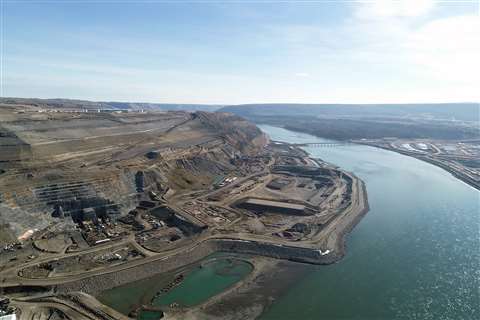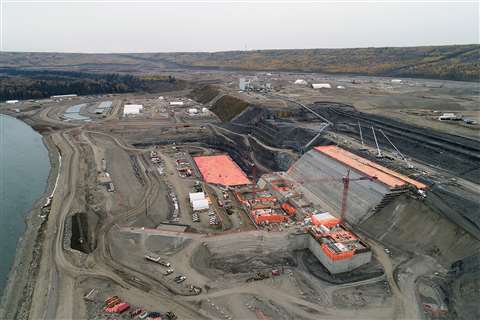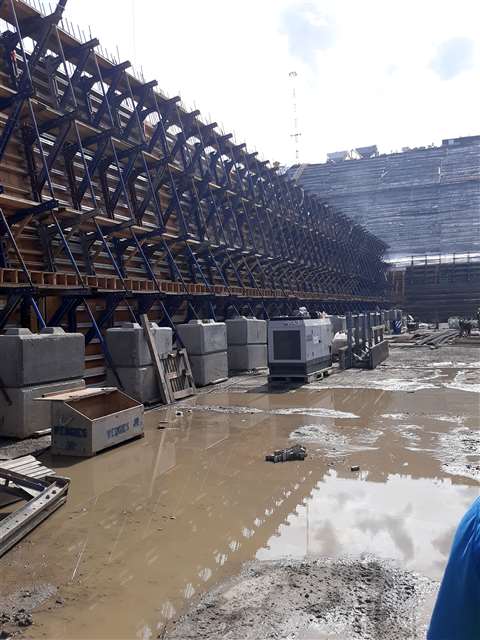Forming & Shoring Solutions wins at innovation
November 29, 2022
Forming & Shoring Solutions (FSS) had only been in business for two years when it was contacted by Peace River Hydro Partners (PRHP) to come up with a material supply solution for a roller-compacted concrete portion of a hydroelectric dam.
 A sky view of the Peace River dam site in Fort St. John, British Columbia. (Photo: FSS)
A sky view of the Peace River dam site in Fort St. John, British Columbia. (Photo: FSS)
“We knew a job of this size would be an accurate, and perhaps unfiltered, test of our capabilities as a new company,” said Justin Revis, FSS owner and founder. “Though we certainly experienced some trepidation and nervousness with the undertaking, we felt excited and more than ready to meet the challenge.”
Referred to PRHP through a long-time industry associate and friend, Lee Schermerhorn, Forming & Shoring Solutions bid on the project – and was awarded the contract shortly thereafter.
Project scope and plans
The nearly 1,200-mile-long Peace River is home to three hydroelectric generating systems which provide electricity to British Columbia. The dam at Site C in Fort St. John, British Columbia, called for a contemporary, clean solution to traditional roller compacted concrete applications as to take advantage of already stored water in a nearby reservoir.
Ground for $2 billion project broke in 2015 and consisted of three main elements: the dam itself, two diversion tunnels and a concrete foundation for the electric generating system.
 A closer look at Peace River dam site C. (Photo: FSS)
A closer look at Peace River dam site C. (Photo: FSS)
The main focus for FSS was the last aspect: providing an 800-meter, roller compacted concrete (RCC) foundation and buttress system.
RCC is known to be greener than traditional mass concrete pours due to the introduction of fly ash into the concrete mix, which allows for lower moisture content and heat generation during the curing process than conventional concrete.
FSS utilized a unique waler design and splice plates at varying degrees along with push/pull braces to create a self-supporting formwork system. This approach allowed for three tiers of working capabilities and access for every 30 feet of concrete lift.
“Using innovative approaches to traditional gang-forming systems allowed us to meet our intended operational and performance criteria on this job,” FSS said.
Beyond-the-normal jobsite ‘problems’
As with any multi-year undertaking, FSS faced difficulties along the way, noting some obstacles were run-of-the-mill ordinary and expected, but others presented a whole new range of challenges.
“Slight tie removal issues were solved by adding the option of swivel nut plates,” the company said. “Additionally, a change in [our] bolt manufacturer resulted in unforeseen compliance concerns, which were quickly resolved by altering the form hardware.”
 The unique waler design, varying splice plate degrees and use of push pull braces created a self-supporting formwork system, as seen here. (Photo: FSS)
The unique waler design, varying splice plate degrees and use of push pull braces created a self-supporting formwork system, as seen here. (Photo: FSS)
However, the company also experienced unexpected and extraordinary challenges, as well. Extenuating factors unique to western Canada – structure stability through seismic protection via the concrete buttressing system and climatic conditions that affect workload capacity and time constraints – called for FSS to take extra special considerations into account.
And then there was the pandemic and its massive impact on both domestic and international businesses, logistics and production. Covid-19 and related lockdowns resulted in Forming & Shoring Solutions experiencing an 80 percent reduction in manpower at its shipping facility along with limited services as it complied with government recommended guidelines. The bright spot however was that the company did not experience any disruptions in international trucking, as it had taken pre-emptive measures to secure essential freight during the early months of 2020.
Next steps for Peace River project
Since its contract start date in 2017, Forming & Shoring Solution supplied more than 40 truckloads of standard and customized product totaling $3 million. The entire project is expected to bring in over $3 billion in construction-related gross domestic product (GDP) to the region.
The Peace River project is scheduled to be finished in 2025. Once completed, the dam will generate 35 percent of available energy with only 5 percent of reservoir utilization and will provide power to more than 500,000 Canadian homes and businesses.
Peace River project facts and figuresProducts supplied by Forming & Shoring Solutions for the RCC phase of the dam build included:
|
300%Increase in PRHP’s pour rate from 2017 to 2018 $3 billionTotal construction-related GDP the project will have brought to the region 500,000Homes and businesses to be powered by energy from the dam’s electric generating system 40Truckloads of product delivered by FSS |
STAY CONNECTED



Receive the information you need when you need it through our world-leading magazines, newsletters and daily briefings.
CONNECT WITH THE TEAM








